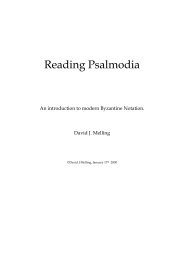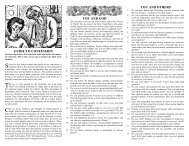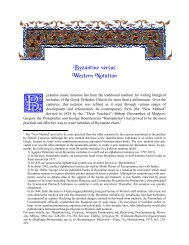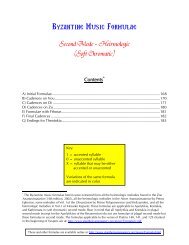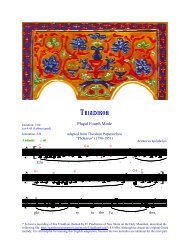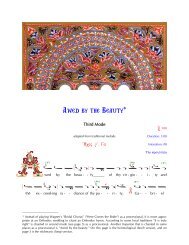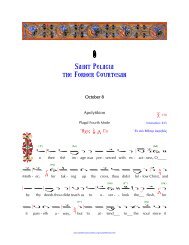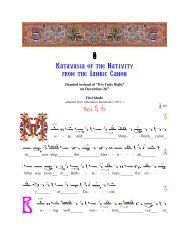- Page 3 and 4: VespersAs chanted on the Holy Mount
- Page 5: ContentsConcerning Adaptation .....
- Page 9: Contents viiSunday ................
- Page 12 and 13: xConcerning AdaptationThe first ada
- Page 14 and 15: xiiConcerning AdaptationThis adapta
- Page 16 and 17: xivConcerning AdaptationThis adapta
- Page 18 and 19: xviConcerning AdaptationThis adapta
- Page 20 and 21: xviiiConcerning AdaptationComparing
- Page 22 and 23: xxConcerning AdaptationAs with the
- Page 24 and 25: xxiiConcerning AdaptationThe versio
- Page 26 and 27: xxivConcerning AdaptationThe follow
- Page 28 and 29: About the TranslationOUR previous b
- Page 32 and 33: RubricsAS in the standard Greek Ana
- Page 37 and 38: Intonation: #1(see Appendix)Andante
- Page 39 and 40: Let My PrayerFirst ModeAndanteÚ•
- Page 41 and 42: First Mode - Verses of Psalms 54& b
- Page 43 and 44: First Mode - Verses of Psalms 7& b
- Page 45 and 46: First Mode - Verses of Psalms 919&
- Page 47 and 48: KFirst Mode - Slow Stichera 11& b
- Page 49 and 50: First Mode - Slow Stichera 13& b& b
- Page 51 and 52: First Mode - Slow Stichera 15& b D
- Page 53 and 54: & bœ œ œ œfor the Cross and>œ&
- Page 55 and 56: First Mode - Slow Stichera 19& bUn.
- Page 57 and 58: First Mode - Glory 21Alternate Melo
- Page 59 and 60: Andante& b& b& b& bDÚ•¢œ œ œ
- Page 61 and 62: & bœ œ œofD˙God;& b œ œ œ œ
- Page 63 and 64: First Mode - Slow Aposticha 27& bCj
- Page 65 and 66: First Mode - Slow Aposticha 29& b C
- Page 67 and 68: First Mode - Slow Aposticha 31D& b
- Page 69 and 70: Aposticha TheotokionAndanteÚ•¢F
- Page 71 and 72: Allegro& bDÚ¡§ºApolytikion of t
- Page 73 and 74: First Mode - Apolytikion37Resurrect
- Page 75 and 76: Intonation: #1AllegroÚ¡§ºFirst
- Page 77 and 78: Brief SticheraFirst ModeAllegro& b
- Page 79 and 80: First Mode - Brief Stichera43Stiche
- Page 81 and 82:
First Mode - Brief Stichera45& b >
- Page 83 and 84:
First Mode - Brief Stichera47& b œ
- Page 85 and 86:
First Mode - Brief Stichera49& bDj
- Page 87 and 88:
First Mode - Brief Stichera51& bŒ
- Page 89 and 90:
F& bj œFirst Mode - Brief Apostich
- Page 91 and 92:
& b ˙ ,First Mode - Brief Apostich
- Page 93 and 94:
First Mode - Brief Aposticha 57Glor
- Page 95 and 96:
Intonation: #7Andante&Ú•¢Un. G
- Page 97 and 98:
Let My PrayerSecond ModeAndante&Un.
- Page 99 and 100:
Second Mode (Soft Chromatic) - Vers
- Page 101 and 102:
Second Mode (Soft Chromatic) - Vers
- Page 103 and 104:
Second Mode (Soft Chromatic) - Vers
- Page 105 and 106:
Second Mode - Slow Stichera 69& ˙
- Page 107 and 108:
Second Mode - Slow Stichera 71F G&
- Page 109 and 110:
& œ.œ œ œ œ œ> jœœ .,Second
- Page 111 and 112:
Second Mode - Slow Stichera 75&Fœj
- Page 113 and 114:
Second Mode - Slow Stichera 77Stich
- Page 115 and 116:
Second Mode - Slow Stichera 79&Fœj
- Page 117 and 118:
Second Mode - Glory 81Alternate Mel
- Page 119 and 120:
Andante&Ú•¢Un.G ,œ œ œ œ œ
- Page 121 and 122:
Andante&Ú••>F Gœ œ œ œEœ
- Page 123 and 124:
Second Mode - Slow Aposticha 87& ˙
- Page 125 and 126:
Second Mode - Slow Aposticha 89& œ
- Page 127 and 128:
Second Mode - Slow Aposticha 91E&
- Page 129 and 130:
Second Mode - Slow Aposticha Theoto
- Page 131 and 132:
Second Mode - Apolytikion95& œ œ
- Page 133 and 134:
Intonation: #6Allegro& b bÚ¡§ºD
- Page 135 and 136:
Verses of Psalms140, 141, and 129Pr
- Page 137 and 138:
7& b bGDiatonic>œ œ œ œK& b b
- Page 139 and 140:
Second Mode (Hard Chromatic) - Vers
- Page 141 and 142:
Brief SticheraSecond ModeAllegroÚ
- Page 143 and 144:
Second Mode - Brief Stichera107& b
- Page 145 and 146:
Second Mode - Brief Stichera109& b
- Page 147 and 148:
Second Mode - Brief Stichera111D& b
- Page 149 and 150:
Second Mode - Brief Stichera113& bb
- Page 151 and 152:
& b b œ # œ ˙ŒSecond Mode - Bri
- Page 153 and 154:
Second Mode - Brief Aposticha 117&
- Page 155 and 156:
& b b # œ œ ˙ ,Second Mode - Bri
- Page 157 and 158:
Second Mode - Brief Aposticha 121Gl
- Page 159 and 160:
Intonation: #8AndanteÚ•¢Third M
- Page 161 and 162:
Let My PrayerAndante& bÚ•¢> Cœ
- Page 163 and 164:
Third Mode - Verses of Psalms1274&
- Page 165 and 166:
Third Mode - Verses of Psalms12911&
- Page 167 and 168:
Third Mode - Verses of Psalms 13119
- Page 169 and 170:
& b œ œ œ œ œ ˙ ,ofman,& b œ
- Page 171 and 172:
Third Mode - Slow Stichera 135Stich
- Page 173 and 174:
& bCœ œ œfor by Thyœ.Third Mode
- Page 175 and 176:
Third Mode - Slow Stichera 139& b C
- Page 177 and 178:
Third Mode - Slow Stichera 141& bœ
- Page 179 and 180:
Third Mode - Slow Stichera 143& bFj
- Page 181 and 182:
Third Mode - Glory145Alternate Melo
- Page 183 and 184:
Dogmatic TheotokionAndante& bCœ.Ú
- Page 185 and 186:
Third Mode - Dogmatic Theotokion149
- Page 187 and 188:
Third Mode - Slow Aposticha151& bœ
- Page 189 and 190:
Third Mode - Slow Aposticha153Verse
- Page 191 and 192:
Third Mode - Slow Aposticha155Verse
- Page 193 and 194:
Aposticha TheotokionAndanteÚ•¢T
- Page 195 and 196:
AllegroÚ¡§ºApolytikion of theRe
- Page 197 and 198:
DThird Mode - Apolytikion 161& b œ
- Page 199 and 200:
Third Mode - Lord I Have Cried - Br
- Page 201 and 202:
Third Mode - Brief Stichera165& bFj
- Page 203 and 204:
Third Mode - Brief Stichera167& b >
- Page 205 and 206:
Third Mode - Brief Stichera169& bFj
- Page 207 and 208:
Third Mode - Brief Stichera171,& b
- Page 209 and 210:
Third Mode - Brief Stichera173CF& b
- Page 211 and 212:
Brief ApostichaThird ModeAllegro& b
- Page 213 and 214:
Third Mode - Brief Aposticha177& b
- Page 215 and 216:
& b œ œ œ œ ˙ ,FThird Mode - B
- Page 217 and 218:
& b œ œ ˙ , FThird Mode - Brief
- Page 219 and 220:
Fourth Mode - Lord I Have Cried 183
- Page 221 and 222:
Verses of Psalms140, 141, and 129Pr
- Page 223 and 224:
Fourth Mode - Verses of Psalms1877&
- Page 225 and 226:
Fourth Mode - Verses of Psalms 189&
- Page 227 and 228:
Slow SticheraFourth ModeAndante& b
- Page 229 and 230:
Fourth Mode - Slow Stichera 193& b
- Page 231 and 232:
Fourth Mode - Slow Stichera 195& b&
- Page 233 and 234:
& b œ œ > œ œ œwast& b ˙ œ
- Page 235 and 236:
Fourth Mode - Slow Stichera 199& b&
- Page 237 and 238:
Fourth Mode - Slow Stichera 201D& b
- Page 239 and 240:
Fourth Mode - Slow Stichera 203& bD
- Page 241 and 242:
Fourth Mode - Glory205Alternate Mel
- Page 243 and 244:
Dogmatic TheotokionFourth ModeAndan
- Page 245 and 246:
Fourth Mode - Dogmatic Theotokion20
- Page 247 and 248:
Fourth Mode - Slow Aposticha211& bE
- Page 249 and 250:
Fourth Mode - Slow Aposticha213& bD
- Page 251 and 252:
Fourth Mode - Slow Aposticha215& bD
- Page 253 and 254:
Fourth Mode - Slow Aposticha 217E&
- Page 255 and 256:
Fourth Mode - Slow Aposticha Theoto
- Page 257 and 258:
AllegroÚ¡§ºApolytikion of theRe
- Page 259 and 260:
Fourth Mode - Apolytikion 223& œ
- Page 261 and 262:
Fourth Mode - Lord I Have Cried225G
- Page 263 and 264:
Fourth Mode - Brief Stichera227& bG
- Page 265 and 266:
Fourth Mode - Brief Stichera229& b
- Page 267 and 268:
Fourth Mode - Brief Stichera231Stic
- Page 269 and 270:
Fourth Mode - Brief Stichera233& bC
- Page 271 and 272:
Fourth Mode - Brief Stichera235& bU
- Page 273 and 274:
Fourth Mode - Brief Stichera237& b
- Page 275 and 276:
Brief ApostichaFourth ModeAllegroÚ
- Page 277 and 278:
Fourth Mode - Brief Aposticha241,&
- Page 279 and 280:
Fourth Mode - Brief Aposticha243Apo
- Page 281 and 282:
Fourth Mode - Brief Aposticha245& b
- Page 283 and 284:
Intonation: #14 or #15Andante& bD>
- Page 285 and 286:
Let My PrayerAndanteÚ•¢Plagal F
- Page 287 and 288:
Plagal First Mode - Verses of Psalm
- Page 289 and 290:
Plagal First Mode - Verses of Psalm
- Page 291 and 292:
Plagal First Mode - Verses of Psalm
- Page 293 and 294:
yKFPlagal First Mode - Slow Sticher
- Page 295 and 296:
Plagal First Mode - Slow Stichera 2
- Page 297 and 298:
Plagal First Mode - Slow Stichera 2
- Page 299 and 300:
KPlagal First Mode - Slow Stichera
- Page 301 and 302:
FPlagal First Mode - Slow Stichera
- Page 303 and 304:
Plagal First Mode - Slow Stichera 2
- Page 305 and 306:
Glory... Both Now...Plagal First Mo
- Page 307 and 308:
Plagal First Mode - Glory271C1& bD&
- Page 309 and 310:
Plagal First Mode - Dogmatic Theoto
- Page 311 and 312:
Slow ApostichaPlagal First ModeAnda
- Page 313 and 314:
Plagal First Mode - Slow Aposticha
- Page 315 and 316:
Plagal First Mode - Slow Aposticha
- Page 317 and 318:
FPlagal First Mode - Slow Aposticha
- Page 319 and 320:
Plagal First Mode - Slow Aposticha
- Page 321 and 322:
Plagal First Mode - Apolytikion285G
- Page 323 and 324:
Intonation: #13Allegro&Ú¡§ºPlag
- Page 325 and 326:
Verses of Psalms140, 141, and 129Pr
- Page 327 and 328:
7&Plagal First Mode - Verses of Psa
- Page 329 and 330:
Plagal First Mode - Verses of Psalm
- Page 331 and 332:
Brief SticheraPlagal First ModeAlle
- Page 333 and 334:
Plagal First Mode - Brief Stichera2
- Page 335 and 336:
Plagal First Mode - Brief Stichera&
- Page 337 and 338:
& œjœjœPlagal First Mode - Brief
- Page 339 and 340:
Plagal First Mode - Brief Stichera3
- Page 341 and 342:
Plagal First Mode - Brief Stichera3
- Page 343 and 344:
Brief ApostichaPlagal First ModeAll
- Page 345 and 346:
& œ> œ ˙ ,A G Un.œ œ b > œ œ
- Page 347 and 348:
Plagal First Mode - Brief Aposticha
- Page 349 and 350:
Plagal First Mode - Brief Aposticha
- Page 351 and 352:
Plagal Second Mode - Lord I Have Cr
- Page 353 and 354:
Presto1& b bD& bb >œÚ¡•ºDœ
- Page 355 and 356:
7& b bDœPlagal Second Mode - Verse
- Page 357 and 358:
Plagal Second Mode - Verses of Psal
- Page 359 and 360:
Slow SticheraPlagal Second ModeAnda
- Page 361 and 362:
Plagal Second Mode - Slow Stichera3
- Page 363 and 364:
Plagal Second Mode - Slow Stichera3
- Page 365 and 366:
Plagal Second Mode - Slow Stichera3
- Page 367 and 368:
Plagal Second Mode - Slow Stichera3
- Page 369 and 370:
333& b b œ œ œ œ # œhis in - i
- Page 371 and 372:
Plagal Second Mode - Glory335Altern
- Page 373 and 374:
Dogmatic TheotokionAndante& bbÚ•
- Page 375 and 376:
Plagal Second Mode - Dogmatic Theot
- Page 377 and 378:
Plagal Second Mode - Slow Aposticha
- Page 379 and 380:
JPlagal Second Mode - Slow Apostich
- Page 381 and 382:
Plagal Second Mode - Slow Aposticha
- Page 383 and 384:
Andante& bbDœÚ•¢Aposticha Theo
- Page 385 and 386:
Allegro&Ú¡∞ºœ œ œ > œ œ
- Page 387 and 388:
Plagal Second Mode - Apolytikion351
- Page 389 and 390:
Plagal Second Mode - Lord I Have Cr
- Page 391 and 392:
Plagal Second Mode - Verses of Psal
- Page 393 and 394:
Plagal Second Mode - Verses of Psal
- Page 395 and 396:
19&20&& œ21&E G Eœ œ œ > œ œ
- Page 397 and 398:
Plagal Second Mode - Brief Stichera
- Page 399 and 400:
& ˙ ,Plagal Second Mode - Brief St
- Page 401 and 402:
Plagal Second Mode - Brief Stichera
- Page 403 and 404:
Plagal Second Mode - Brief Stichera
- Page 405 and 406:
Plagal Second Mode - Brief Stichera
- Page 407 and 408:
Plagal Second Mode - Brief Stichera
- Page 409 and 410:
Plagal Second Mode - Brief Apostich
- Page 411 and 412:
Plagal Second Mode - Brief Apostich
- Page 413 and 414:
Plagal Second Mode - Brief Apostich
- Page 415 and 416:
Grave ModeIntonation: #21AndanteÚ
- Page 417 and 418:
Let My PrayerAndante& b& bÚ•¢C
- Page 419 and 420:
Grave Mode - Verses of Psalms3834&
- Page 421 and 422:
JGrave Mode - Verses of Psalms38511
- Page 423 and 424:
Grave Mode - Verses of Psalms38719&
- Page 425 and 426:
& b œ œ œ œ œ œ œi - lessGra
- Page 427 and 428:
Grave Mode - Slow Stichera391Stiche
- Page 429 and 430:
Grave Mode - Slow Stichera393D& b >
- Page 431 and 432:
Grave Mode - Slow Stichera395& b œ
- Page 433 and 434:
Grave Mode - Slow Stichera397& b ˙
- Page 435 and 436:
Grave Mode - Slow Stichera399& b F
- Page 437 and 438:
Grave Mode - Slow Stichera 401& b&
- Page 439 and 440:
Grave Mode - Glory403Alternate Melo
- Page 441 and 442:
Dogmatic TheotokionAndante& b>˙Ú
- Page 443 and 444:
Grave Mode - Dogmatic Theotokion 40
- Page 445 and 446:
Grave Mode - Dogmatic Theotokion (D
- Page 447 and 448:
& œ bœœ > Dœ œ œ œ œ œ œ
- Page 449 and 450:
Grave Mode - Slow Aposticha413& bFj
- Page 451 and 452:
Grave Mode - Slow Aposticha415>& b
- Page 453 and 454:
Grave Mode - Slow Aposticha 417& bU
- Page 455 and 456:
Grave Mode - Slow Aposticha Theotok
- Page 457 and 458:
Grave Mode - Slow Aposticha Theotok
- Page 459 and 460:
Grave Mode - Apolytikion423Glory...
- Page 461 and 462:
Intonation: #21Allegro& bÚ¡§ºF
- Page 463 and 464:
Brief SticheraGrave ModeAllegro& bF
- Page 465 and 466:
Grave Mode - Brief Stichera429& bj
- Page 467 and 468:
Grave Mode - Brief Stichera431& bD
- Page 469 and 470:
Grave Mode - Brief Stichera433& b&
- Page 471 and 472:
Grave Mode - Brief Stichera435F& b
- Page 473 and 474:
Grave Mode - Brief Stichera437& b F
- Page 475 and 476:
Brief ApostichaGrave ModeAllegro& b
- Page 477 and 478:
Grave Mode - Brief Aposticha 441Apo
- Page 479 and 480:
Grave Mode - Brief Aposticha 443& b
- Page 481 and 482:
Plagal Fourth ModeIntonation: #26An
- Page 483 and 484:
JLet My PrayerAndante& bCÚ•¢œ
- Page 485 and 486:
Plagal Fourth Mode - Verses of Psal
- Page 487 and 488:
Plagal Fourth Mode - Verses of Psal
- Page 489 and 490:
Plagal Fourth Mode - Verses of Psal
- Page 491 and 492:
& b œn œ œ.œ œ œmer - - -Plag
- Page 493 and 494:
& b . œjœmoth - erDjœ #œ.& b œ
- Page 495 and 496:
Plagal Fourth Mode - Slow Stichera4
- Page 497 and 498:
Plagal Fourth Mode - Slow Stichera4
- Page 499 and 500:
Plagal Fourth Mode - Slow Stichera4
- Page 501 and 502:
Glory... Both Now...Plagal Fourth M
- Page 503 and 504:
Plagal Fourth Mode - Glory467Old (S
- Page 505 and 506:
Plagal Fourth Mode - Dogmatic Theot
- Page 507 and 508:
Andante& bCÚ••œ ˙ œ œ œTh
- Page 509 and 510:
JPlagal Fourth Mode - Slow Apostich
- Page 511 and 512:
Plagal Fourth Mode - Slow Aposticha
- Page 513 and 514:
JPlagal Fourth Mode - Slow Apostich
- Page 515 and 516:
qPlagal Fourth Mode - Slow Apostich
- Page 517 and 518:
Plagal Fourth Mode - Apolytikion481
- Page 519 and 520:
Intonation: #24Allegro& bÚ¡§ºPl
- Page 521 and 522:
Brief SticheraPlagal Fourth ModeAll
- Page 523 and 524:
Plagal Fourth Mode - Brief Stichera
- Page 525 and 526:
Plagal Fourth Mode - Brief Stichera
- Page 527 and 528:
Plagal Fourth Mode - Brief Stichera
- Page 529 and 530:
Plagal Fourth Mode - Brief Stichera
- Page 531 and 532:
Plagal Fourth Mode - Brief Stichera
- Page 533 and 534:
Plagal Fourth Mode - Brief Apostich
- Page 535 and 536:
Plagal Fourth Mode - Brief Apostich
- Page 537 and 538:
Plagal Fourth Mode - Brief Apostich
- Page 539 and 540:
I Shall Gointo Thy HouseDuration: 2
- Page 541 and 542:
I Shall Go into Thy House 505D& b
- Page 543 and 544:
Anoixantaria - Phokaeus507& b œ œ
- Page 545 and 546:
Anoixantaria - Phokaeus509G F G C G
- Page 547 and 548:
Anoixantaria - Phokaeus511& b ˙œ
- Page 549 and 550:
Anoixantaria - Phokaeus513& bœ œ
- Page 551 and 552:
JAnoixantaria - Phokaeus515& bnœ#
- Page 553 and 554:
Anoixantaria - Phokaeus517& bHard C
- Page 555 and 556:
JAnoixantaria - Phokaeus519& b œ
- Page 557 and 558:
Anoixantaria - Phokaeus521Glory...&
- Page 559 and 560:
Anoixantaria - Phokaeus 523C& b œ
- Page 561 and 562:
J& b œ œ œ œ œ œ œ œ& b& b,
- Page 563 and 564:
FJJHAnoixantaria - Raidestenos 527&
- Page 565 and 566:
HJ& bœJœ.˙ ,Anoixantaria - Raide
- Page 567 and 568:
J& b n > ,œ œ œ œ œ œ œ ˙&
- Page 569 and 570:
Anoixantaria - Raidestenos 533& b,
- Page 571 and 572:
Anoixantaria - Raidestenos 535Verse
- Page 573 and 574:
J& b& b,˙œ œ œ.LarghettoAHard C
- Page 575 and 576:
DC>& b œ.œ œ œ ˙ œ& b# œ œ
- Page 577 and 578:
Anoixantaria - Raidestenos 541C& b
- Page 579 and 580:
Anoixantaria - Raidestenos 543G& b
- Page 581 and 582:
FAnoixantaria - St. John Koukouzele
- Page 583 and 584:
& b œ.jœ œ.Anoixantaria - St. Jo
- Page 585 and 586:
Anoixantaria - St. John Koukouzeles
- Page 587 and 588:
& b > ,œ œ œ œ œ œ œ ˙œ.j
- Page 589 and 590:
Anoixantaria - St. John Koukouzeles
- Page 591 and 592:
Anoixantaria - St. John Koukouzeles
- Page 593 and 594:
& b& b># œ œ œ œ.œ œ œ œUn.
- Page 595 and 596:
Anoixantaria - Elaborate Finale 559
- Page 597 and 598:
Anoixantaria - Elaborate Finale 561
- Page 599 and 600:
Anoixantaria - Elaborate Finale 563
- Page 601 and 602:
Blessed is the Man - Long Version56
- Page 603 and 604:
JBlessed is the Man - Long Version5
- Page 605 and 606:
& b œ.jœ bœœ œ œ œ œ nœœ
- Page 607 and 608:
Blessed is the Man - Long Version57
- Page 609 and 610:
Blessed is the Man - Long Version57
- Page 611 and 612:
Blessed is the Man - Long Version57
- Page 613 and 614:
Blessed is the Man - Long Version57
- Page 615 and 616:
Blessed is the Man - Long Version57
- Page 617 and 618:
Blessed is the Man - Long Version58
- Page 619 and 620:
Blessed is the Man(psalms 1-3)Brief
- Page 621 and 622:
Blessed is the Man - Brief Version5
- Page 623 and 624:
KBlessed is the Man - Brief Version
- Page 625 and 626:
Blessed is the Man - Brief Version5
- Page 627 and 628:
Blessed is the Man - Brief Version5
- Page 629 and 630:
Blessed is the Man - Brief Version5
- Page 631 and 632:
Duration: 5:45 + 3:45Intonation: #1
- Page 633 and 634:
& b& b>œ, j >œ œ œ œ œ.œ œ
- Page 635 and 636:
& b . œ& b,˙jœ ˙˙- to TheeDœ.
- Page 637 and 638:
& b& b˙,Dœ.œ œ œ œ.ing up (n)
- Page 639 and 640:
Duration: 5:30 + 3:45Intonation: #2
- Page 641 and 642:
Lord I Have Cried - Very Slow Versi
- Page 643 and 644:
Lord I Have Cried - Very Slow Versi
- Page 645 and 646:
& # Soft Chromatic:Un. D,œ “ œ
- Page 647 and 648:
Verses of Psalms140, 141, and 129Du
- Page 649 and 650:
Verses of Psalms - Triple Meter - F
- Page 651 and 652:
Verses of Psalms - Triple Meter - F
- Page 653 and 654:
Verses of Psalms - Triple Meter - F
- Page 655 and 656:
Verses of Psalms140, 141, and 129Du
- Page 657 and 658:
Verses of Psalms - Triple Meter - P
- Page 659 and 660:
12& b b& b b13& bbD˙œWhen my# œ
- Page 661 and 662:
Verses of Psalms - Triple Meter - P
- Page 663 and 664:
& œ œ œ œ œ œ .,O Joyous Ligh
- Page 665 and 666:
& œ,œ œ # œ œ.Un.Gjœ œ œ œ
- Page 667 and 668:
&Ú¡•ºPrestoSecond ModeFirst Ch
- Page 669 and 670:
Daily Prokeimena633Monday VespersFo
- Page 671 and 672:
Daily Prokeimena635Wednesday Vesper
- Page 673 and 674:
Daily Prokeimena637Friday VespersGr
- Page 675 and 676:
& b& b,œ.jœC>œ# œ œ œ œ œ
- Page 677 and 678:
Lenten Prokeimena 641"Thou Hast Giv
- Page 679 and 680:
Intonation: #21AndanteÚ•º& b F
- Page 681 and 682:
Great Prokeimena645For Bright Monda
- Page 683 and 684:
Great Prokeimena647Intonation: #21&
- Page 685 and 686:
Great Prokeimena 649Intonation: #26
- Page 687 and 688:
Rich Men Have Turned Poor - Brief V
- Page 689 and 690:
& b œ œ œ.œ œ œ œ œ œ.& b
- Page 691 and 692:
Rich Men Have Turned Poor - Long Me
- Page 693 and 694:
FRich Men Have Turned Poor - Long M
- Page 695 and 696:
O Theotokos and Virgin - Georgiadis
- Page 697 and 698:
O Theotokos and Virgin - Georgiadis
- Page 699 and 700:
O Theotokos and Virgin - Georgiadis
- Page 701 and 702:
O Theotokos and VirginPlagal First
- Page 703 and 704:
O Theotokos and VirginDuration: 1:4
- Page 705 and 706:
Petitions are intonedat G and/or CA
- Page 707 and 708:
Lord Have Mercy - Plagal Fourth Mod
- Page 709 and 710:
Lord Have Mercy - Plagal Fourth Mod
- Page 711 and 712:
Lord Have MercyPlagal First ModePet
- Page 713 and 714:
Lord Have Mercy - Plagal First Mode
- Page 715 and 716:
Lord Have Mercy - Plagal First Mode
- Page 717 and 718:
Lord Have Mercyadapted from Athonit
- Page 719 and 720:
Grant This O LordPlagal Fourth Mode
- Page 721 and 722:
Grant This O Lord - Plagal Fourth M
- Page 723 and 724:
Grant This O Lord - Plagal First Mo
- Page 725 and 726:
SourcesThe music for all the hymns
- Page 727 and 728:
AppendixThe Intonations of the Eigh
- Page 729 and 730:
Appendix - The Intonations of the E
- Page 731 and 732:
Appendix - The Intonations of the E
- Page 733 and 734:
Appendix - The Intonations of the E



